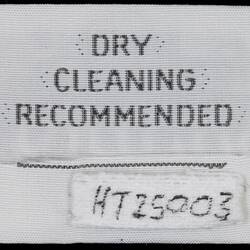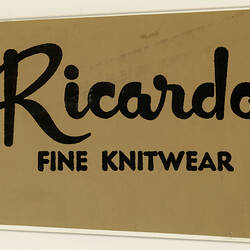Summary
Garment label produced for Ricardo Knitwear, a Melbourne firm that specialised in expensive, classic knitwear for men and women. The company was based in Johnston Street, Collingwood and operated from 1958 to 1978. It was founded by Richard Charlupski, a Polish migrant who arrived in Australia in 1950.
Richard named the company 'Ricardo Knitwear' to play on the public perception that Italian knitwear was the finest in the world. While Richard had some workers in his factory much of the work was done by outworkers, of whom the most important was Edda Azzola, a migrant from Pontebba, Italy. Richard regarded Italian migrant women as the best workers in the knitwear industry and employed them exclusively. Ricardo knitwear was sold in Myer and David Jones department, top-end boutiques and the exclusive Georges department store.
Physical Description
Woven white fabric rectangular label with dark grey embroidered text on obverse and reverse. The front features the wool mark logo.
Significance
Ricardo Knitwear represents the intersection of three powerful forces in post-war Australian life: the changing face of society through migration; the increasing confidence of Australian consumers, and the continuing importance of the wool industry. Ricardo Knitwear was one of many small businesses that flourished in 1950s and 1960s Melbourne to supply fashion to a market that started to embrace local designers and manufacturers rather than British or European imports. These businesses were often founded by migrants and most of the their workers, almost entirely women, were also recent migrants to Australia. Richard Charlupski, the founder of Ricardo Knitwear and himself a Polish refugee who arrived in 1950, exclusively employed Italian migrant women to manufacture his garments. Ricardo Knitwear garments were made entirely from Australian merino wool and between 1963 and 1978 won many Australian Fashion Awards. The awards were an initiative set up by the Australian Wool Board to promote Australian wool on the international stage, and some of Ricardo Knitwear's garments were chosen to represent Australia at Expo 67 in Montreal. By the time Ricardo Knitwear closed in 1978, Australian garment manufacturing was in rapid decline due to reduced tariffs and a corresponding surge in cheap imports.
More Information
-
Collecting Areas
-
Acquisition Information
Donation from Mr Richard Charlupski - Ricardo Knitwear, 07 May 2010
-
Manufactured For
Ricardo Knitwear, Johnson Street, Collingwood, Greater Melbourne, Victoria, Australia, 1958-1978
-
Place & Date Used
Johnston Street, Collingwood, Greater Melbourne, Victoria, Australia, 1958-1978
-
Inscriptions
Obverse: Ricardo / MADE IN AUSTRALIA / 40 / 18 / PURE NEW WOOL Reverse: DRY CLEANING RECOMMENDED
-
Classification
Manufacturing & industry, Clothing & fashion, Fashion designers
-
Category
-
Discipline
-
Type of item
-
Overall Dimensions
47 mm (Width), 30 mm (Height)
-
Keywords
Clothing Trade, Immigration, Labels, Small Businesses, Textile Industry, Wool Fabrics & Textiles




